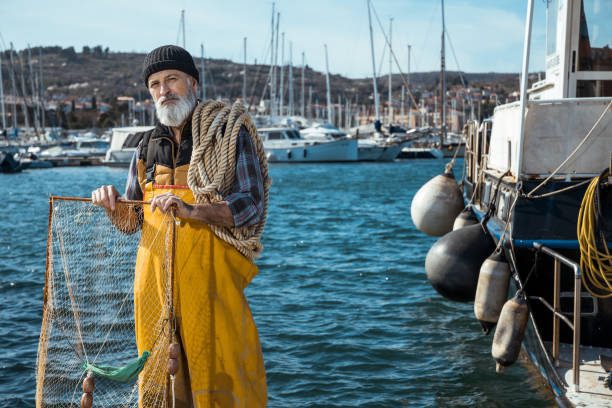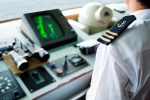
| Crab Fisherman Key Stats | |
|---|---|
| Education | 0-6 Months |
| Job Outlook | 2% |
If you enjoy fishing, want a big pay package, and are not afraid to face some of the deadliest storms in the ocean, then you might like to become a crab fisherman.
It’s no easy feat since you’ll need plenty of training and experience before your first big catch, and you’ll face some big risks.
Of course, you probably already know that you can be rewarded with a pretty big pay for just 48-72 hours of work.
If you love watching Deadliest Catch, you may be interested in finding out how to become a crab fisherman yourself.
Crab fishermen are made of tough stuff, and this is certainly a hard job where you risk serious injury and even your life.
Table of Contents
Education Requirements to Become a Crab Fisherman
If you want to become a crab fisherman, you’ll need to be living in Alaska or Seattle, as this is where most crab fishing occurs.
Some crab fishermen live in other parts of the country, and stay in Alaska seasonally.
Because of this, many are away from friends and family for weeks and even months at a time.
The first prerequisite for this job is physical strength.
If you’re not fit, it’s time to hit the gym.
Work on developing excellent cardiovascular fitness with an activity like running or cycling.
You will also need excellent strength.
Doing weights regularly, or taking up a job that involves a lot of labor such as construction will help.
Getting a job as a crab fisherman can be tricky, since you’ll have to do some work on other vessels first.
A good place to start getting experience is through the fish or crab processors.
You’ll spend time working on the docks packing, then may be able to work on salmon boats where the work is somewhat less demanding.
You won’t see job opportunities for crab fisherman advertised.
Most work is given out due to reputation and word of mouth.
Once you have some experience behind you, you might like to approach boat captains and let them know of your intention to become a crab fisherman.
Eventually one of them will give you a chance, and you’ll be ready for your first trip out as a crab fisherman.
Crab Fisherman Job Description
In 1980, there were 200 million pounds of king crab caught in the waters off Alaska.
Now there are less than 14 million.
The season is very short, in the winter months.
At one point, the season was just 4 days long.
Currently it is about 4-6 weeks.
There is only a small window of opportunity to catch these creatures, and the conditions in which it can occur are incredible dangerous.
Working as a crab fisherman is tough.
The fatality rate of an Alaskan crab fisherman is 90 times that of an ordinary worker.
Special fishing boats equipped to deal with freezing conditions head out for days, or sometimes weeks, in search of king crab.
Steep traps, called pots, are lowered into the water with fish used as bait for the crabs.
The pot is left on the sea floor, and marked with a buoy.
It is left for 1-2 days, and then retrieved.
Once the pot is retrieved, the crabs are held in tanks on the boat.
Any that don’t meet regulations are thrown back.
If the crabs freeze they will burst, and release a toxin that kills other crabs.
If they are left too long in the tank they will start attacking each other, and are known for having cannibalistic qualities.
There is pressure to catch as much as possible and also return the existing crabs to the shore.
Here are some of the duties of a crab fisherman:
- Maintaining cleanliness of a ship
- Setting pots
- Retrieving pots and sorting the catch
- Returning small catches to the ocean
- Removing dead crabs form the tank
- Selling crabs on shore
Crab Fisherman Salary and Career Path
When you become a crab fisherman, you will start out as a greenhorn.
This is an industry term for someone who is new to the industry.
You’ll be given the chance to learn the ropes, while you’ll still be expected to work hard.
Once you’ve proven yourself, you’ll become a full share deck hand.
Some fishermen go on to become captains, or to own their own boats.
Once on shore, the catch will be sold and the profits divided amongst the crew.
They could make no money at all, or tens of thousands of dollars for a few days work.
A greenhorn gets a set amount of money for the trip, no matter the results of the catch.
Some similar roles that you might be interested include:
- Ship Captain
- Boat Mechanic
- Sailor
If you’re tough, not afraid of risk, and want the chance to make some big money, then you might like to become a crab fisherman.
It’s a difficult job, both demanding and also hard to get a start, but there are also excellent rewards available for those that can take on this dangerous job.
![]() The below information is based on the 2023 BLS national averages.
The below information is based on the 2023 BLS national averages.
National Average Salary
$39,970Average Salary by State
| State | Avg. Annual Salary |
|---|---|
| Alabama | $42,720 |
| Alaska | $50,350 |
| Arizona | $37,840 |
| Arkansas | $39,200 |
| California | $38,590 |
| Colorado | $43,350 |
| Connecticut | $42,210 |
| Delaware | $39,910 |
| District of Columbia | $56,130 |
| Florida | $34,490 |
| Georgia | $43,570 |
| Hawaii | $43,910 |
| Idaho | $42,950 |
| Illinois | $43,950 |
| Indiana | $42,320 |
| Iowa | $44,010 |
| Kansas | $39,740 |
| Kentucky | $39,030 |
| Louisiana | $47,060 |
| Maine | $44,630 |
| Maryland | $41,820 |
| Massachusetts | $46,490 |
| Michigan | $42,660 |
| Minnesota | $46,080 |
| Mississippi | $41,170 |
| Missouri | $39,060 |
| Montana | $43,530 |
| Nebraska | $44,730 |
| Nevada | $41,710 |
| New Hampshire | $40,860 |
| New Jersey | $39,660 |
| New Mexico | $35,560 |
| New York | $43,520 |
| North Carolina | $39,840 |
| North Dakota | $47,410 |
| Ohio | $44,370 |
| Oklahoma | $39,910 |
| Oregon | $42,890 |
| Pennsylvania | $41,590 |
| Rhode Island | $41,500 |
| South Carolina | $41,200 |
| South Dakota | $39,830 |
| Tennessee | $38,160 |
| Texas | $38,060 |
| Utah | $41,820 |
| Vermont | $45,490 |
| Virginia | $43,450 |
| Washington | $43,660 |
| West Virginia | $39,240 |
| Wisconsin | $40,390 |
| Wyoming | $37,550 |
| Guam | $37,100 |
| Puerto Rico | $24,640 |
| Virgin Islands | $36,960 |
The top earning state in the field is District of Columbia, where the average salary is $56,130.
These are the top 5 highest-paying states in the field:
* Employment conditions in your area may vary.
Frequently Asked Questions
What does a crab fisherman do?
Crab fishermen work on a crab boat and spend weeks and months at a time on the sea trying to fill the crab quota.
Crab finishing has been considered the most dangerous job in America for a long time but new regulations have reduced the number of fatalities and increased earnings for fishermen.
However, this is still a dangerous job and crab fishermen need physical strength and stamina as they have to work in harsh conditions.
Most crab fishing takes place in the Bering Sea and crab fishermen have to face some of the most intense and dangerous storms.
If you want to become a crab fisherman, there are job centers in Alaska that can guide you through the process.
How much does a crab fisherman make?
According to the Bureau of Labor Statistics, the median annual wage for fishing and hunting workers was $28,530 as of May 2017.
Crab fishermen are usually paid a percentage of the boat’s overall catch, so if the fishing expedition is successful and the crab quota is met the payment is expected to be good.
A crab boat can bring nearly a million dollars in a successful trip so as a crab worker you can earn as much as $50,000 in just a few days or weeks of work.
How much does it cost to become a crab fisherman?
There are no formal educational requirements if you want to join this profession as a greenhorn on a crab fishing boat.
However, many regions require a fishing license.
If you want to become a crab fisherman you can start by earning some fishing experience and trying to find entry-level employment on a crab boat.
Keep in mind that you will need to be physically fit in order to face the harsh conditions on a crab fishing boat.
What is the demand for crab fishermen?
According to the Bureau of Labor Statistics, the demand for fishing and hunting workers is projected to decline 2 percent from 2018 to 2028.
As crab rationalization laws have recently been put in place, fewer boats go out each year and the number of fishermen needed for the trip has been reduced.
There are around 250 crab boats that go out each season in Alaska and each boat employs around 5-6 deckhands on average.
Your job prospects depend on your skills and determination.
How long does it take to become a crab fisherman?
There are no formal educational requirements for crab fishermen and you may be hired even if you don’t have any previous experience if you convince the boat captain that you have the determination and skills needed to perform this job.
Although you will learn this trade mostly on the job, having some fishing experience should give you better job prospects.













